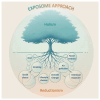An evolutionary perspective for the exposome
- PMID: 39867564
- PMCID: PMC7617335
- DOI: 10.1093/exposome/osae008
An evolutionary perspective for the exposome
Abstract
The exposome was proposed following the realization that most human diseases have an environmental rather than a genetic (hereditary) origin. Non-communicable diseases are, in fact, the consequence of multiple exposures that activate a sequence of stages in a multistage process that already starts in early life. This attracted attention to both the multiplicity (in fact, potentially the totality) of exposures humans are exposed to since conception and to the life-long perspective of disease causation. In this paper, we examine an extension of the exposome concept that incorporates a Darwinian approach based on the concept of phenotypic plasticity. One of the theses is that interpreting exposome science as "precision environmental research" is only a partial interpretation, largely focused on chemical exposures, while a broadening of the perspective is needed, also in light of the planetary crisis. Such broadening involves the incorporation of basic concepts from evolutionary biology and medicine, including the ability of organisms to adapt to rapidly changing environments. We refer in particular to cancer and "Darwinian carcinogenesis."
Keywords: agnostic research; environment; evolutionary theory; human health; phenotypic plasticity; theory-driven research.
Conflict of interest statement
Conflict of interest statement None declared.
Figures

Similar articles
-
The exposome as the science of social-to-biological transitions.Environ Int. 2022 Jul;165:107312. doi: 10.1016/j.envint.2022.107312. Epub 2022 May 21. Environ Int. 2022. PMID: 35635963 Review.
-
Adolescent idiopathic scoliosis (AIS), environment, exposome and epigenetics: a molecular perspective of postnatal normal spinal growth and the etiopathogenesis of AIS with consideration of a network approach and possible implications for medical therapy.Scoliosis. 2011 Dec 2;6(1):26. doi: 10.1186/1748-7161-6-26. Scoliosis. 2011. PMID: 22136338 Free PMC article.
-
Implications of the exposome for exposure science.J Expo Sci Environ Epidemiol. 2011 Jan-Feb;21(1):5-9. doi: 10.1038/jes.2010.50. Epub 2010 Nov 17. J Expo Sci Environ Epidemiol. 2011. PMID: 21081972 Review.
-
The Minderoo-Monaco Commission on Plastics and Human Health.Ann Glob Health. 2023 Mar 21;89(1):23. doi: 10.5334/aogh.4056. eCollection 2023. Ann Glob Health. 2023. PMID: 36969097 Free PMC article. Review.
-
Use of an Exposome Approach to Understand the Effects of Exposures From the Natural, Built, and Social Environments on Cardio-Vascular Disease Onset, Progression, and Outcomes.Front Public Health. 2020 Aug 12;8:379. doi: 10.3389/fpubh.2020.00379. eCollection 2020. Front Public Health. 2020. PMID: 32903514 Free PMC article. Review.
References
-
- Wild CP. The exposome: from concept to utility. Int J Epidemiol. 2012;41(1):24–32. - PubMed
-
- Haenszel W, Kurihara M, Segi M, Lee RK. Stomach cancer among Japanese in Hawaii. J Natl Cancer Inst. 1972;49(4):969–988. - PubMed
-
- Ahmedin J, Vineis P, Bray F, Torre L, Forman D. Cancer Atlas, American Cancer Society. 2014
LinkOut - more resources
Full Text Sources
